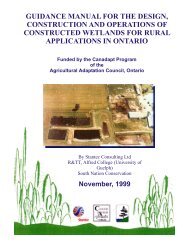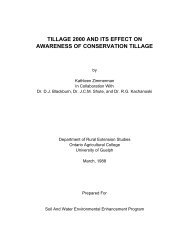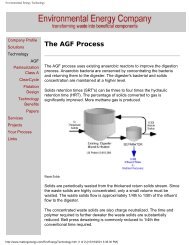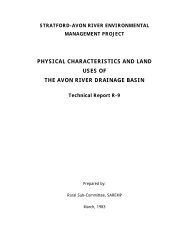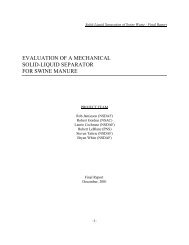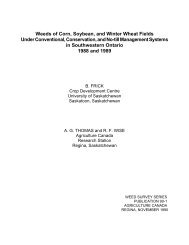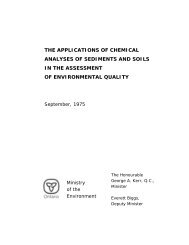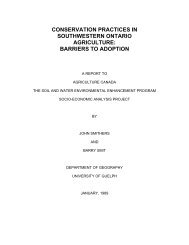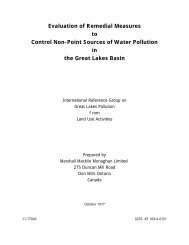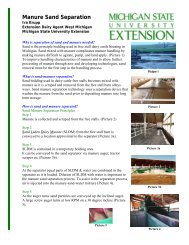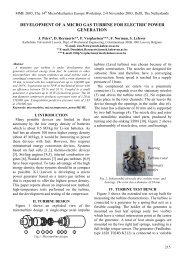Environmental Aspects of Phosphate and Potash Mining United ...
Environmental Aspects of Phosphate and Potash Mining United ...
Environmental Aspects of Phosphate and Potash Mining United ...
Create successful ePaper yourself
Turn your PDF publications into a flip-book with our unique Google optimized e-Paper software.
<strong>Environmental</strong> <strong>Aspects</strong> <strong>of</strong> <strong>Phosphate</strong> <strong>and</strong> <strong>Potash</strong> <strong>Mining</strong><br />
Water Management <strong>and</strong> Treatment<br />
The Foskor Ltd. operation at Phalaborwa is located in<br />
the semi-arid northeast <strong>of</strong> South Africa, adjacent to the<br />
Selati River <strong>and</strong> upstream from the Kruger National<br />
Park.<br />
The processing operation uses 250 million litres <strong>of</strong><br />
water per day, the majority <strong>of</strong> which is recirculated.<br />
Excess water is transferred to the tailings dam before<br />
release to the Selati River. The tailings water is high in<br />
both total dissolved solids (TDS) <strong>and</strong> sulfates. The sulfates<br />
are largely introduced with tailings sourced from<br />
the adjacent Phalaborwa Copper mine, which currently<br />
supplies about 40% <strong>of</strong> the phosphate ore feed for the<br />
Foskor beneficiation plant.<br />
Concerns by Kruger National Park management about<br />
the potential effect <strong>of</strong> contaminated water on the<br />
downstream aquatic ecosystem led to the implementation<br />
<strong>of</strong> a water treatment system.<br />
After consideration <strong>of</strong> the most suitable water treatment<br />
processes on the market, the ‘Paques’ process was<br />
selected. This bacterial process converts sulfates in the<br />
tailings water to sulfur.The sulfur is subsequently recovered<br />
<strong>and</strong> sold to the adjacent fertilizer processing<br />
complex for use in the production <strong>of</strong> sulfuric acid.<br />
The process is used to treat about 40 to 50 mega-litres<br />
per day. Monitoring <strong>of</strong> the release is conducted as part<br />
<strong>of</strong> a comprehensive surface <strong>and</strong> ground water monitoring<br />
system for the site that includes biological<br />
monitoring points located on the Selati River.<br />
The water treatment system protects the downstream<br />
aquatic ecosystem <strong>and</strong> the natural values <strong>of</strong> the Kruger<br />
National Park. Additionally, the sulfur by-product can be<br />
sold to recover a portion <strong>of</strong> the operating costs.<br />
Selati River flowing adjacent to the tailings dam - Foskor<br />
Ltd, South Africa<br />
Water Contamination<br />
Surface <strong>and</strong> ground water contamination may occur<br />
through the release or seepage <strong>of</strong> tailings effluent <strong>and</strong><br />
brines from dams, ponds <strong>and</strong> stacks. Contaminants<br />
might include clay fines, chemical reagents, sulfates,<br />
salt <strong>and</strong> magnesium chloride. In addition, rainfall may<br />
dissolve salt tailings or cause erosion <strong>and</strong> mobilize<br />
fines.<br />
Depending on the operation, water releases are<br />
required to maintain the water balance <strong>of</strong> the operations<br />
storage facilities. In most countries, this water<br />
must meet established water quality st<strong>and</strong>ards. To<br />
achieve this, excess water is treated through a system<br />
<strong>of</strong> dams <strong>and</strong> wetl<strong>and</strong>s to clarify <strong>and</strong> remove contaminants.<br />
Where possible clean water <strong>and</strong> contaminated water<br />
on the mine site are kept separate <strong>and</strong> h<strong>and</strong>led<br />
through different systems, to reduce the quantity <strong>of</strong><br />
water that must be treated before release.<br />
Aquatic species are sometimes used as an indicator <strong>of</strong><br />
the performance <strong>of</strong> the waste management system.<br />
Monitoring the biodiversity <strong>of</strong> aquatic species downstream<br />
from release points provides an indicator <strong>of</strong><br />
environmental response.<br />
The leakage <strong>of</strong> liquid wastes such as brines from storage<br />
<strong>and</strong> disposal ponds is controlled to a large extent<br />
by containment techniques such as plastic or clay liners,<br />
ditches, drains <strong>and</strong> containment pumping wells.<br />
L<strong>and</strong>scape Disturbance<br />
The construction <strong>and</strong> operation <strong>of</strong> surface waste storage<br />
facilities typically disturbs a significant area <strong>of</strong><br />
l<strong>and</strong>. Some operations have reduced the area affected<br />
by stacking wastes higher. In other cases, wastes are<br />
disposed <strong>of</strong> to mined-out areas, avoiding impacts on<br />
undisturbed areas.<br />
Rehabilitation <strong>of</strong> disposal areas to mitigate environmental<br />
effects is discussed in Sections 3.7 “Closure”<br />
<strong>and</strong> 3.8 “Rehabilitation”.<br />
Tailings Stability <strong>and</strong> Failure<br />
The potential for accidental failure <strong>of</strong> waste disposal<br />
dams <strong>and</strong> ponds is <strong>of</strong> concern. This can cause rapid,<br />
extensive <strong>and</strong> widespread impacts on the surrounding<br />
environment. The installation <strong>of</strong> monitoring systems,<br />
preparation <strong>of</strong> emergency response plans <strong>and</strong> procedures,<br />
<strong>and</strong> the regular auditing <strong>of</strong> performance assist



